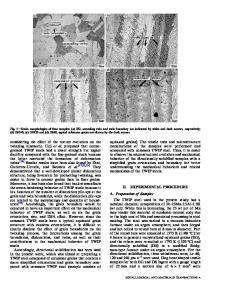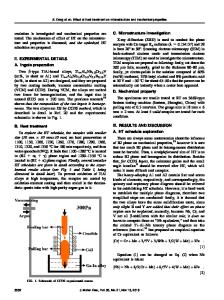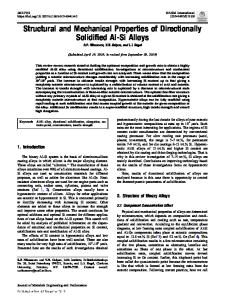Effect of Growth Rate on Microstructure and Mechanical Properties of the Directionally Solidified Nb-Si Eutectic Alloy
- PDF / 2,164,265 Bytes
- 6 Pages / 612 x 792 pts (letter) Page_size
- 42 Downloads / 321 Views
BB5.25.1
Effect of Growth Rate on Microstructure and Mechanical Properties of the Directionally Solidified Nb-Si Eutectic Alloy Nobuaki Sekido1, Yoshisato Kimura, and Yoshinao Mishima Department of Materials Science and Engineering, Tokyo Institute of Technology, Yokohama 226-8502, Japan 1 Now with Department of Materials Science and Engineering, University of Wisconsin-Madison, Madison, WI 53706, U.S.A ABSTRACT The development of ultra-high temperature structural materials having superior mechanical properties to the nickel based superalloys has been pursued in the niobium silicide based composites. The unidirectional solidification technique was performed on the (Nb)/Nb3Si eutectic alloy in the Nb-Si binary system. A continuity of Nb phases in the eutectic microstructure increases with decreasing a growth rate, which yields the enhancement of fracture toughness as well as high temperature strength. The mechanisms of microstructural formation, toughening, and strengthening are briefly discussed. INTRODUCTION The unidirectional solidification technique provides a wide variety of possible applications for various metallic and ceramic materials. Since the toughness of ductile-phase-toughened (DPT) composite materials is greatly influenced not only by the volume fraction of ductile phase but also by its size and morphology [1-4], microstructural control through the directional solidification would be one of the solutions to improve the toughness of the DPT composite materials. If the ductile phase is well aligned with the eutectic microstructure, the toughness of the alloys should be effectively enhanced due to the extrinsic toughening mechanisms such as crack trapping and crack bridging. Therefore, the special interest in the present study is placed on controlling microstructure using the unidirectional solidification technique on the (Nb)/Nb3Si eutectic alloy in the Nb-Si binary system. The room temperature fracture toughness and high-temperature strength of directionally solidified (DS) alloys were evaluated by chevron-notch fracture toughness measurement and compression test, respectively. The toughening and strengthening mechanisms of the DS alloys are discussed focusing on the distinctive microstructural features. EXPERIMENTAL PROCEDURES The unidirectional solidification was performed on the Nb-17.5Si alloys ((Nb)/Nb3Si eutectic composition [5]), using the optical floating zone (OFZ) furnace at rates from 10 to 200 mm/h in a flowing Ar gas atmosphere. Some of the DS alloys were wrapped with Nb foil, and then annealed at 1773 K for 500 h under vacuum in order to decompose the high temperature phase Nb3Si into (Nb) and Nb5Si3. Microstructural observation was performed by scanning electron microscope (SEM), and quantitative microstructural evaluation was conducted by a digital image recording and processing program combined with SEM. The chevron-notch fracture toughness measurement was conducted by four-point bending using an Instron type testing machine at a cross-head speed of 50 µm/min. Test specimens, having di
Data Loading...











